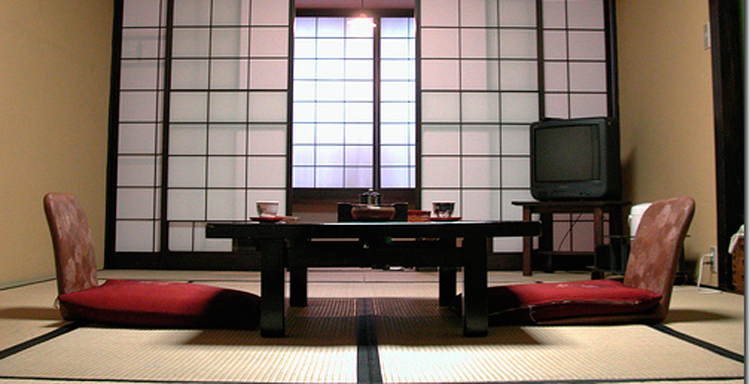Small or large, expensive or cheap, a ryokan always offers the same deal: a welcome, a tatami-floored room, a refreshing pot of tea, a relaxing bath, a dinner including local specialities, a comfortable bed, and a traditional breakfast. And all but the bath are provided in the same tatami room.
Prices vary depending on the location of the ryokan, the quality and uniqueness of the food, the venerability and fame of the building, the level of service provided and sometimes how much you can afford!
A ryokan in a scenic hot-spring resort, with famous health-giving waters, hundreds of years old and still with the original timber, and the site of a famous fight in ancient times between rival bands of samurai, and with excellent food – well, this isn’t one of the cheap ones!
The routine is unvaried and comforting: the weary travellers arrive, and are effusively welcomed, carefully divested of their shoes and given slippers for use inside the inn. You are shown to your room, and promptly take your slippers off to step into your tatami room through the sliding shoji screen door. In the room will be a simple table – about 18 inches high – onto which a tea tray will soon be placed while the maid bustles about with the luggage. Tea is poured, and the guests kneel or sit at the low table, and relax. Yukata – full-length cotton dressing gowns are put out. These are for wearing when moving around the public areas of the inn, (and in some resort towns are even acceptable outside).
There is usually one large communal bathroom for each sex. There is a process: first you wash, then rinse, then you bath. There may be a shower, or small taps low down on the wall of the bathroom with dippers for pouring water over your head while you squat or perch on a plastic stool. In any event, only once you are thoroughly clean and thoroughly soap-free may you head for the bath, which will be very hot indeed. Take it slowly, and relax, then towel off and head back to the room.
Your meal will be already laid out, and the maid waiting to serve you. In a more expensive ryokan, the maid will stay with you and serve every course. Even if you can’t speak a word of Japanese, you’ll be shown what to eat, in what order, and you won’t go hungry or thirsty.
The evening meal is a major factor in the cost of a stay. The emphasis is on tradition, and the menu is whatever the chef decides you are going to eat. It will always include the basics: rice, pickles, miso soup and fish, and there will be multiple small dishes, focussing on local and regional specialities, served with cold sake and tea.
Dinner over, the maid will lay out your futon mattresses on the floor and make your beds, and will clear away the table and the dinner things, and leave you for the night. Your journey, the incredibly relaxing bath and your dinner will act as the best sleeping tonic you’ve ever tried, and you’ll have a great night’s sleep.
Breakfast will also be a traditional Japanese meal, and again the maid will appear, clear away the beds and serve the meal.
There are about 55,000 ryokan in Japan and prices range from $80 to more than $1600 a night. They continue to survive in country areas, but have been pushed out of most major towns: they are just too expensive to run compared to a western-style hotel.
Teruo Murakami, The owner of Ochiairou Murakami Ryokan in Izu, south west of Tokyo, firmly believes in preserving the old traditions nevertheless.
“Even younger Japanese prefer western style hotels over a ryokan these days, but it is important that Japanese traditions are kept alive and inherited through the generations,” he says. “Hotels provide a very solitary experience. Usually a hotel room is only for sleeping in, while a ryokan provides a friendlier, personal touch.
“A ryokan is not only about providing a bed to sleep in, but experiencing Japan, its culture and unique traditions.”
